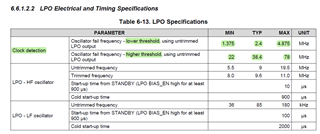Other Parts Discussed in Thread: HALCOGEN
Hello,
Considering this statement: 'The valid OSCIN frequency range is defined as: fCLK10M / 4 < fOSCIN < fCLK10M * 4.", is the "Low Power Oscillator and Clock Detect" capable of detecting variation of 50ppm?
Is the value of HF LPO related to the frequency of the crystal? In this video: www.ti.com/.../3871660449001, the crystal is 16MHz and PLL1 is 160MHz and the HF LPO is 10. If yes, what is the value to use in HALCoGEN to configure the HF LPO to the monitor the oscillator when the crystal is 16MHz and PLL1 is 300MHz?
Regards,
Marcio Borges.



